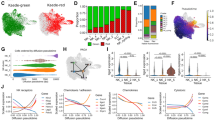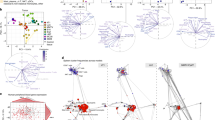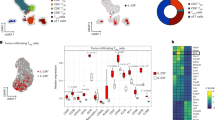Abstract
Natural killer (NK) cells are innate immune cells with the ability to identify and eliminate transformed cells. However, within tumors, many studies have described NK cells as non-functional. The developmental stage of tumor-associated NK cells and how this may relate to functionality has not been explored. We examined the developmental state of NK cells from polyoma middle T antigen (pyMT) transgenic mouse (MMTV-pMT) breast tumors. In pyMT tumors, NK cells were immature as evidenced by their decreased expression of DX5 and their CD27lowCD11blow phenotype. These immature NK cells also had increased expression of NKG2A and expressed low levels of NKp46, perforin, and granzyme B. In contrast, splenic NK cells isolated from the same mice maintained their maturity and their expression of activation markers. To delineate whether the tumor microenvironment directly alters NK cells, we adoptively transferred labeled NK cells and followed their activation status in both the spleen and the tumor. NK cells that arrived at the tumor had half the expression of NKp46 within three days of transfer in comparison to those which arrived at the spleen. In an effort to modify the tumor microenvironment and assess the plasticity of intratumoral NK cells, we treated pyMT tumors with IL-12 and anti-TGF-β. After one week of treatment, the maturity of tumor-associated NK cells was increased; thus, indicating that these cells possess the ability to mature and become activated. A better understanding of how NK cells are modified by the tumor microenvironment will help to develop strategies aimed at bolstering immune responses against tumors.
This is a preview of subscription content, access via your institution
Access options
Subscribe to this journal
Receive 12 digital issues and online access to articles
$119.00 per year
only $9.92 per issue
Buy this article
- Purchase on Springer Link
- Instant access to full article PDF
Prices may be subject to local taxes which are calculated during checkout








Similar content being viewed by others
References
Srivastava S, Lundqvist A, Childs RW . Natural killer cell immunotherapy for cancer: a new hope. Cytotherapy 2008; 10: 775–783.
Kiessling R, Klein E, Wigzell H . “Natural” killer cells in the mouse. I. Cytotoxic cells with specificity for mouse Moloney leukemia cells. Specificity and distribution according to genotype. Eur J Immunol 1975; 5: 112–117.
Gillgrass A, Ashkar A . Stimulating natural killer cells to protect against cancer: recent developments. Expert Rev Clin Immunol 2011; 7: 367–382.
Vivier E, Colonna M . (Eds.). Immunobiology of Natural Killer Cell Receptors. Springer-Verlag Berlin Heidelberg, 2006, Vol. VIII, p. 284.
Di Santo JP . Natural killer cell developmental pathways: a question of balance. Annu Rev Immunol 2006; 24: 257–286.
Puzanov IJ, Bennett M, Kumar V . IL-15 can substitute for the marrow microenvironment in the differentiation of natural killer cells. J Immunol 1996; 157: 4282–4285.
Huntington ND, Vosshenrich CA, Di Santo JP . Developmental pathways that generate natural-killer-cell diversity in mice and humans. Nat Rev Immunol 2007; 7: 703–714.
Chiossone L et al. Maturation of mouse NK cells is a 4-stage developmental program. Blood 2009; 113: 5488–5496.
Fu B et al. CD11b and CD27 reflect distinct population and functional specialization in human natural killer cells. Immunology 2011; 133: 350–359.
Kim S et al. In vivo natural killer cell activities revealed by natural killer cell-deficient mice. Proc Natl Acad Sci U S A 2000; 97: 2731–2736.
Street SE et al. Host perforin reduces tumor number but does not increase survival in oncogene-driven mammary adenocarcinoma. Cancer Res 2007; 67: 5454–5460.
Mamessier E et al. Human breast cancer cells enhance self tolerance by promoting evasion from NK cell antitumor immunity. J Clin Invest 2011; 121: 3609–3622.
Richards J et al. Tumor growth decreases NK and B cells as well as common lymphoid progenitor. PLoS One 2008; 3: e3180.
Richards JO et al. Tumor growth impedes natural-killer-cell maturation in the bone marrow. Blood 2006; 108: 246–252.
Xia J et al. Prevention of spontaneous breast carcinoma by prophylactic vaccination with dendritic/tumor fusion cells. J Immunol 2003; 170: 1980–1986.
De Colvenaer V et al. CD27-deficient mice show normal NK-cell differentiation but impaired function upon stimulation. Immunol Cell Biol 2011; 89: 803–811.
Rosmaraki EE et al. Identification of committed NK cell progenitors in adult murine bone marrow. Eur J Immunol 2001; 31: 1900–1909.
Waldhauer I, Steinle A . NK cells and cancer immunosurveillance. Oncogene 2008; 27: 5932–5943.
Vivier E et al. Functions of natural killer cells. Nat Immunol 2008; 9: 503–510.
Nausch N, Cerwenka A . NKG2D ligands in tumor immunity. Oncogene 2008; 27: 5944–5958.
Gasser S et al. The DNA damage pathway regulates innate immune system ligands of the NKG2D receptor. Nature 2005; 436: 1186–1190.
Halfteck GG et al. Enhanced in vivo growth of lymphoma tumors in the absence of the NK-activating receptor NKp46/NCR1. J Immunol 2009; 182: 2221–2230.
Arteaga CL et al. Anti-transforming growth factor (TGF)-beta antibodies inhibit breast cancer cell tumorigenicity and increase mouse spleen natural killer cell activity. Implications for a possible role of tumor cell/host TGF-beta interactions in human breast cancer progression. J Clin Invest 1993; 92: 2569–2576.
Marcenaro E et al. IL-12 or IL-4 prime human NK cells to mediate functionally divergent interactions with dendritic cells or tumors. J Immunol 2005; 174: 3992–3998.
Yuzhalin AE, Kutikhin AG . Interleukin-12: clinical usage and molecular markers of cancer susceptibility. Growth Factors 2012; 30: 176–191.
Carrega P et al. Natural killer cells infiltrating human nonsmall-cell lung cancer are enriched in CD56 bright CD16(-) cells and display an impaired capability to kill tumor cells. Cancer 2008; 112: 863–875.
Konjevic G et al. Investigation of NK cell function and their modulation in different malignancies. Immunol Res 2012; 52: 139–156.
Gogali F et al. CD3(-)CD16(-)CD56(bright) immunoregulatory NK cells are increased in the tumor microenvironment and inversely correlate with advanced stages in patients with papillary thyroid cancer. Thyroid 2013; 23: 1561–1568.
Garcia-Iglesias T et al. Low NKp30, NKp46 and NKG2D expression and reduced cytotoxic activity on NK cells in cervical cancer and precursor lesions. BMC Cancer 2009; 9: 186.
Platonova S et al. Profound coordinated alterations of intratumoral NK cell phenotype and function in lung carcinoma. Cancer Res 2011; 71: 5412–5422.
Narni-Mancinelli E et al. Fate mapping analysis of lymphoid cells expressing the NKp46 cell surface receptor. Proc Natl Acad Sci U S A 2011; 108: 18324–18329.
Gill S et al. Rapid development of exhaustion and downregulation of eomesodermin limits the anti-tumor activity of adoptively transferred murine natural killer cells. Blood 2012; 119: 5758–5768.
Wilson EB et al. Human tumour immune evasion via TGF-beta blocks NK cell activation but not survival allowing therapeutic restoration of anti-tumour activity. PLoS One 2011; 6: e22842.
Allan DS et al. TGF-beta affects development and differentiation of human natural killer cell subsets. Eur J Immunol 2010; 40: 2289–2295.
Li J, Hunter CA, Farrell JP . Anti-TGF-beta treatment promotes rapid healing of Leishmania major infection in mice by enhancing in vivo nitric oxide production. J Immunol 1999; 162: 974–979.
Loza MJ et al. Expression of type 1 (interferon gamma) and type 2 (interleukin-13, interleukin-5) cytokines at distinct stages of natural killer cell differentiation from progenitor cells. Blood 2002; 99: 1273–1281.
Bruno A et al. The proangiogenic phenotype of natural killer cells in patients with non-small cell lung cancer. Neoplasia 2013; 15: 133–142.
Lima PD et al. Heterogeneity in composition of mouse uterine natural killer cell granules. J Leukoc Biol 2012; 92: 195–204.
Jin J et al. CD11b(-)CD27(-) NK cells are associated with the progression of lung carcinoma. PLoS One 2013; 8: e61024.
Acknowledgements
This work was supported by a grant from the Canadian Breast Cancer Foundation (CBCF). Amy Gillgrass was supported by a PhD. Fellowship from CBCF.
Author information
Authors and Affiliations
Corresponding author
Ethics declarations
Competing interests
All authors declare no competing financial interests.
Additional information
Supplementary information accompanies the paper on Cellular & Molecular Immunology website (http://www.nature.com/cmi).
Supplementary information
Rights and permissions
About this article
Cite this article
Krneta, T., Gillgrass, A., Chew, M. et al. The breast tumor microenvironment alters the phenotype and function of natural killer cells. Cell Mol Immunol 13, 628–639 (2016). https://doi.org/10.1038/cmi.2015.42
Received:
Revised:
Accepted:
Published:
Issue Date:
DOI: https://doi.org/10.1038/cmi.2015.42
Keywords
This article is cited by
-
The role of the natural killer (NK) cell modulation in breast cancer incidence and progress
Molecular Biology Reports (2022)
-
The new progress in cancer immunotherapy
Clinical and Experimental Medicine (2022)
-
Natural killer cell therapy for hematologic malignancies: successes, challenges, and the future
Stem Cell Research & Therapy (2021)
-
NK and NKT cells have distinct properties and functions in cancer
Oncogene (2021)
-
Induced pluripotent stem cell-derived natural killer cells gene-modified to express chimeric antigen receptor-targeting solid tumors
International Journal of Hematology (2021)



